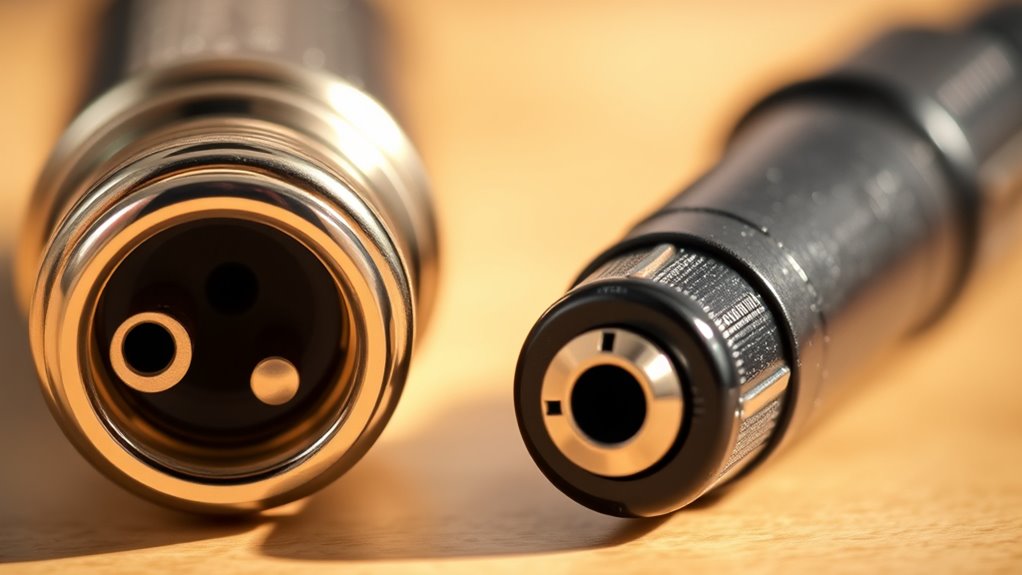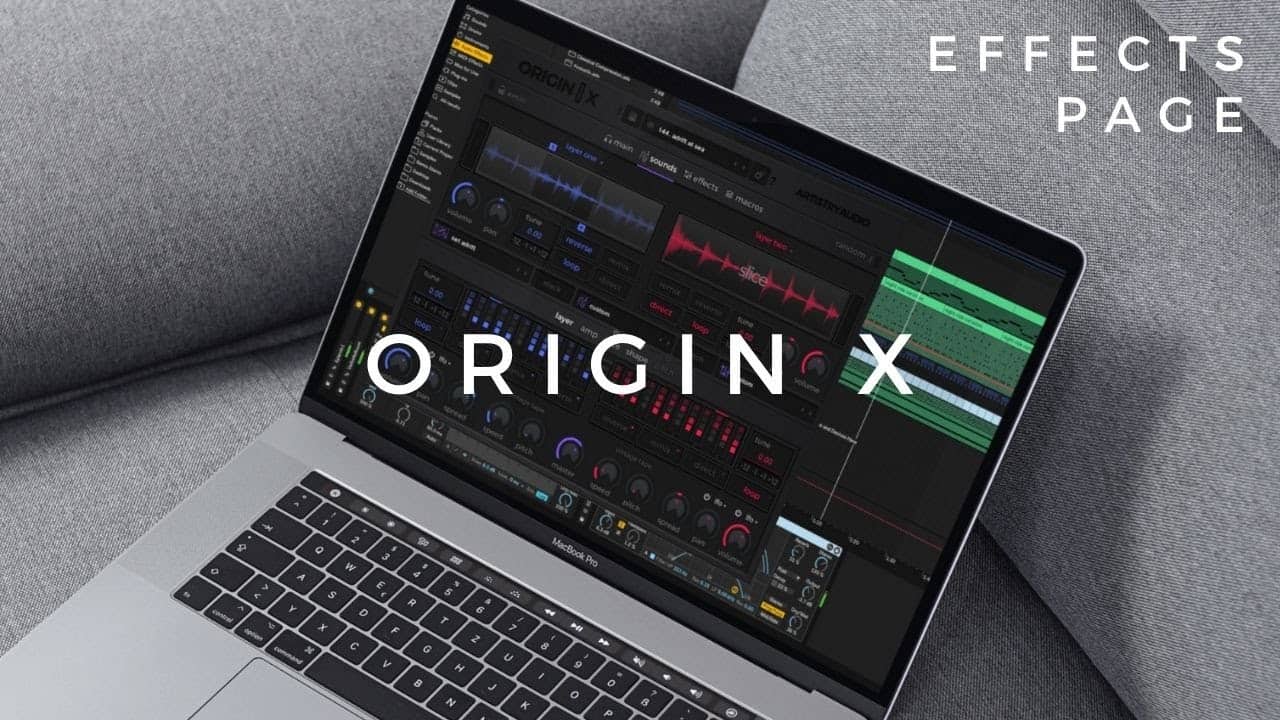When comparing XLR and 3.5mm audio, you should know XLR offers cleaner, more reliable sound thanks to its balanced connections and noise rejection, ideal for professional scenarios. Meanwhile, 3.5mm is smaller and more convenient for casual or portable use but can be prone to static and interference. Your choice depends on your environment, equipment, and needs—if you explore the details, you’ll discover how to make the best connection for your setups.
Key Takeaways
- XLR provides balanced, noise-resistant audio ideal for professional video and photo shoots, unlike unbalanced 3.5mm connections prone to interference.
- 3.5mm jacks are more portable and easier to connect quickly, but less durable and more susceptible to signal degradation.
- For critical audio in noisy environments, XLR offers superior sound fidelity and long-term reliability over 3.5mm connectors.
- Using XLR often requires additional equipment like mixers or interfaces, making setup more complex than the simple plug-and-play of 3.5mm.
- Wireless options enhance flexibility for both XLR and 3.5mm, but XLR still ensures higher quality in professional camera and video workflows.
The Core Differences Between XLR and 3.5mm Connectors
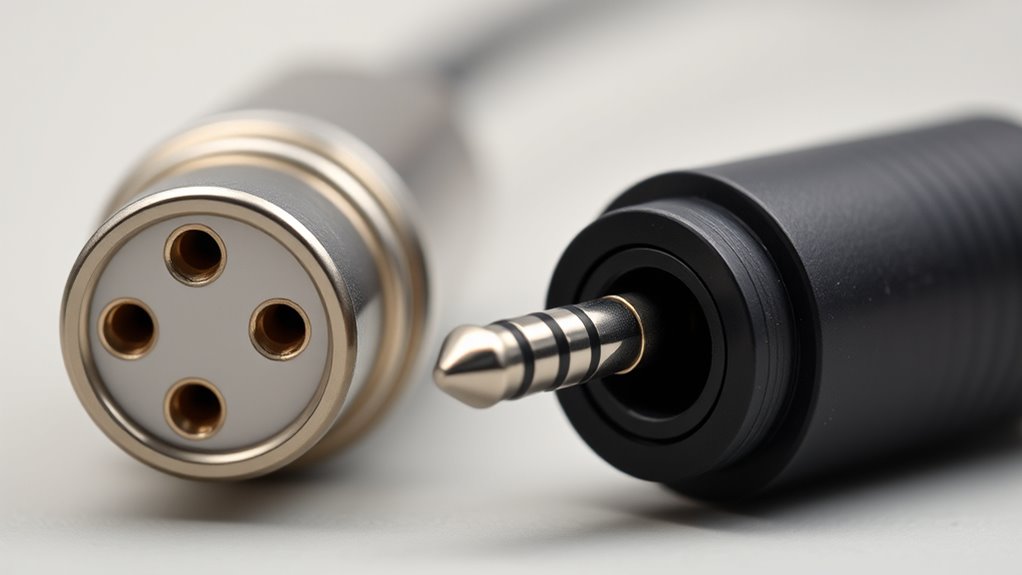
While both XLR and 3.5mm connectors are used for audio connections, they serve different purposes and are built for different environments. XLR connectors feature a robust connector design that guarantees secure, locking connections, making them ideal for professional settings. Their symmetrical design minimizes noise and interference, supporting balanced signal transmission over long distances. In contrast, 3.5mm connectors are smaller and more convenient, with a simple design suited for consumer devices like smartphones and laptops. They typically support unbalanced signal transmission, which is more susceptible to interference. Additionally, audio connection types influence the overall sound quality and reliability in various scenarios. Understanding these core differences helps you choose the right connector based on your needs—whether durability and high-quality transmission or portability and ease of use.
How Audio Quality Varies Between the Two Types
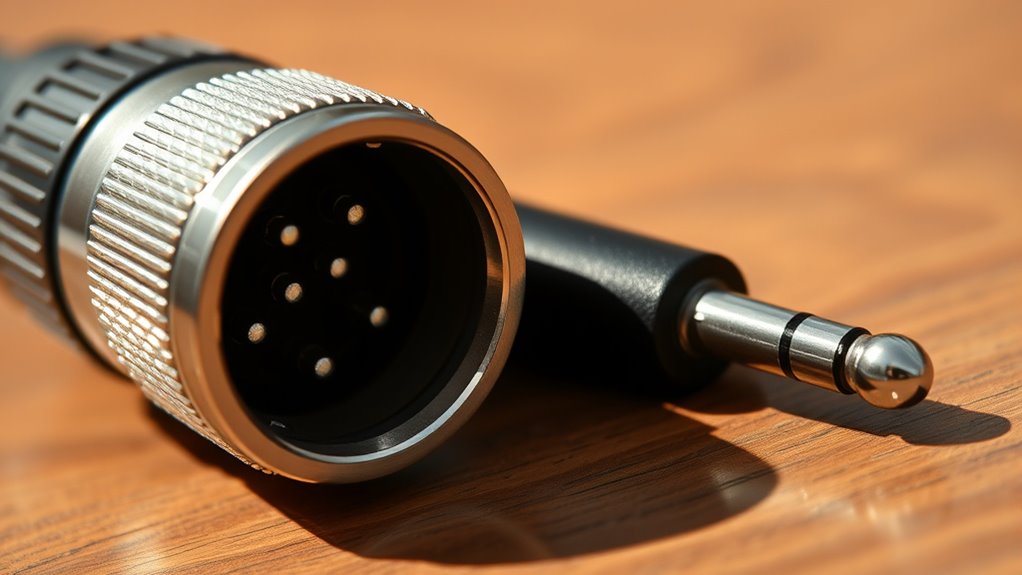
The audio quality you experience with XLR and 3.5mm connectors differs considerably due to their design and intended use. XLR connections generally deliver better audio signal integrity because they’re designed for professional-grade audio equipment, minimizing signal loss and interference. They also tend to have lower noise susceptibility, resulting in cleaner sound, especially in challenging environments. In contrast, 3.5mm connectors are more vulnerable to noise and signal degradation, mainly because they’re often used with consumer devices that don’t prioritize audio quality. This susceptibility can introduce static, hum, or other unwanted noise, reducing overall clarity. While 3.5mm jacks are convenient, they typically don’t match the consistent, high-quality audio output you get from XLR connections, especially in professional settings. Additionally, the signal fidelity of XLR connections makes them the preferred choice for critical audio applications.
Compatibility and Equipment Integration Considerations
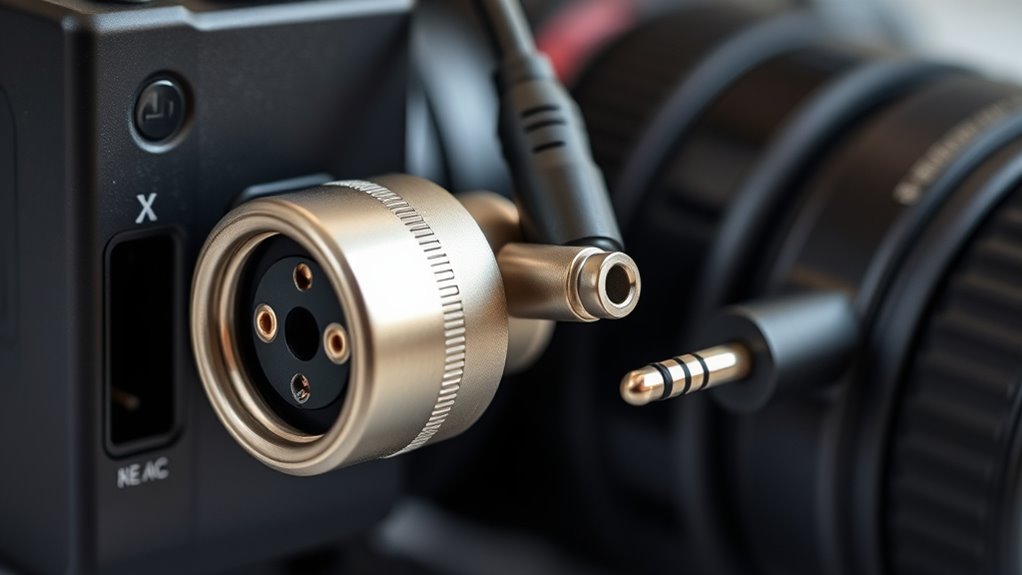
When choosing between XLR and 3.5mm audio connections, you need to contemplate device compatibility and what equipment you already have. Some devices may require adapters or special cables to connect properly, which can add complexity. Additionally, connecting different types of gear can pose challenges, so understanding these compatibility issues is key to seamless integration. Considering the effectiveness of audio connections can help you determine which option best suits your needs.
Device Compatibility Limits
Device compatibility is a key factor to contemplate when choosing between XLR and 3.5mm audio connections, as not all equipment supports both types equally. Some cameras or audio interfaces may lack the necessary ports or backing for certain connections, especially when considering wireless options or power requirements. You might find that your portable recorder only accepts 3.5mm, while your professional microphone demands XLR inputs. Additionally, certain devices require powered connections, limiting compatibility with passive cables. Think about the physical constraints—smaller ports might not fit larger connectors, and some gear may need adapters or powered interfaces. It’s also important to consider audio device compatibility to ensure seamless integration with your existing equipment.
Adapter and Cable Needs
Choosing the right adapters and cables is essential for seamless integration between your audio equipment. You need to factor in cable length to avoid unnecessary clutter or signal loss, especially when connecting devices at different distances. Shorter cables are ideal for close setups, while longer ones provide flexibility but may introduce interference. When selecting adapter types, verify compatibility with your devices—XLR adapters are suited for professional microphones, whereas 3.5mm adapters work well with consumer gear. Confirm that your adapters support the necessary connections and audio quality. Using the correct combination of cable length and adapter types helps prevent connectivity issues and maintains audio integrity, ensuring your setup functions smoothly and reliably. Proper planning now saves frustration during operation. Additionally, understanding the audio connection standards associated with each type can further optimize your setup and prevent potential issues.
Equipment Connectivity Challenges
Ensuring compatibility between your audio equipment can be challenging because different devices often use varying connection standards and voltages. For example, matching microphone types with the right input can be tricky, especially when dealing with XLR versus 3.5mm jacks. Wireless options introduce additional complexity, requiring proper pairing and signal compatibility. You might encounter issues like mismatched voltages or incompatible connectors that hinder setup. Visualize plugging a professional condenser microphone into a camera’s 3.5mm port or trying to integrate wireless mics with outdated gear. Keep in mind:
- Connecting a high-impedance microphone to a low-voltage input
- Syncing wireless microphone systems with cameras
- Ensuring adapters support the necessary power and signal levels
HEPA Filtration is essential for capturing small particles effectively in audio equipment setups that involve air quality considerations for equipment longevity. Addressing these challenges helps achieve seamless equipment integration.
Ease of Use and Setup Challenges

While both XLR and 3.5mm connections are generally straightforward to set up, they each come with their own ease-of-use considerations. XLR connections tend to have more setup complexity because they often require additional accessories like microphones, audio interfaces, or mixers, which can be intimidating for beginners. They’re less user-friendly in quick, casual setups but excel in professional environments where stability matters. Conversely, 3.5mm jacks are simpler and more intuitive, making them ideal for quick connections and portable use. They’re more user-friendly, especially for those less experienced with audio gear. However, they may require extra adapters or cables for certain devices, which can add a minor layer of setup complexity. Additionally, AI security concerns highlight the importance of secure connections and proper handling of audio equipment to prevent vulnerabilities. Overall, your choice depends on balancing setup simplicity with your specific audio needs.
Cost Implications and Durability Factors
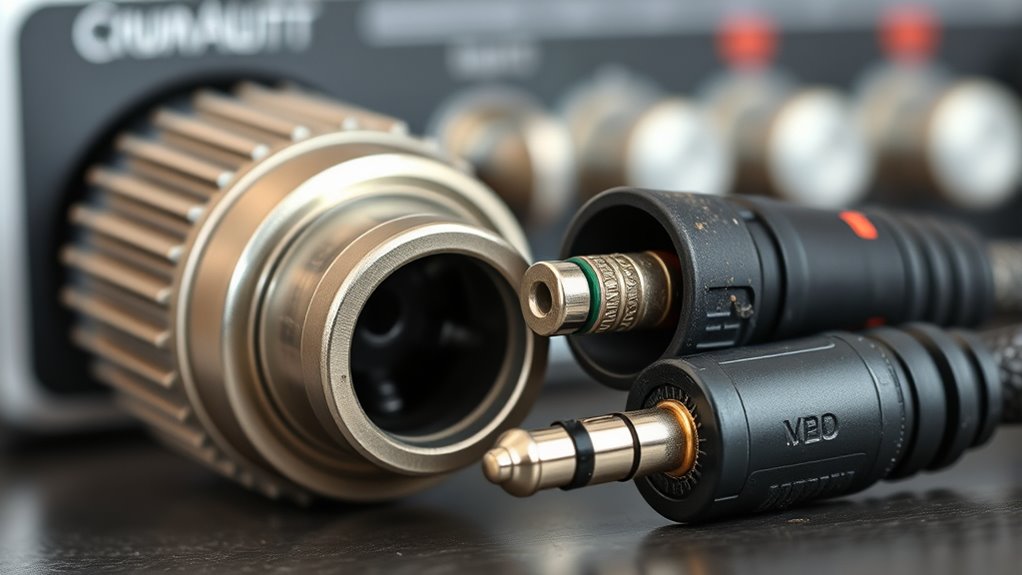
When comparing the cost implications of XLR and 3.5mm connections, you’ll find that XLR setups often require a higher initial investment due to the need for specialized equipment like microphones, audio interfaces, and mixers. This means your cost analysis should factor in the expense of quality cables and accessories designed for durability. XLR cables tend to be more robust, with sturdy connectors and thicker shielding, making them more durable over time. In contrast, 3.5mm cables are usually cheaper but more susceptible to wear and tear, especially with frequent plugging and unplugging. Additionally, cable durability plays a crucial role in long-term usage, as more durable cables tend to last significantly longer and reduce replacement costs. Imagine a heavy-duty XLR cable that withstands rough handling for years, visualize a thin 3.5mm cable fraying after months of use, and think of a professional-grade XLR connector maintaining a secure connection through constant use.
Choosing the Right Connection for Your Recording Environment
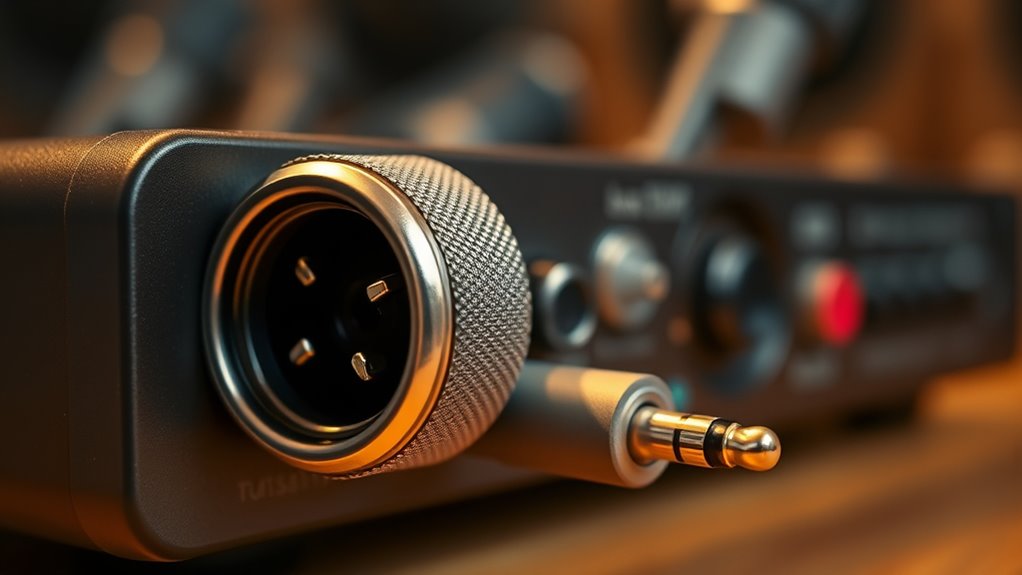
When selecting a connection, you need to take into account your recording environment and how compatible your equipment is. Think about whether your devices support XLR or 3.5mm inputs, and how flexible your setup needs to be. Making the right choice ensures better sound quality and smoother workflows. Additionally, considering tuning options can help optimize audio performance for specific recording scenarios.
Environment Compatibility Considerations
Choosing the right connection depends heavily on your recording environment. If you’re working in a noisy setting, like a bustling studio or outdoor location, an XLR connection offers better noise rejection, ensuring cleaner audio. Consider your power supply: some environments lack stable power, making battery-powered equipment more reliable. For quiet, controlled spaces, a 3.5mm connection may suffice for simpler setups. Visualize your environment with these scenarios:
- A busy street with ambient environmental noise
- A location with inconsistent or unstable power sources
- A professional studio with controlled acoustics
Matching your connection type to these conditions helps you achieve ideal sound quality without interference or power issues. Always assess your surroundings before choosing your setup. Additionally, understanding the environmental compatibility of your equipment can prevent technical issues and improve overall recording quality.
Device Connection Flexibility
Device connection flexibility plays a crucial role in ensuring your recording setup adapts seamlessly to different environments. With wireless transmission options, you can eliminate the need for physical cables, making setups more portable and reducing clutter. This is especially useful when recording on the go or in tight spaces. Additionally, consider the power supply requirements—XLR connections often need external power, while 3.5mm jacks typically draw power from connected devices. Assess whether your equipment supports wireless connectivity or requires wired connections for stability. Compatibility with smart devices can enhance your setup’s versatility by allowing remote control and automation. Flexibility in device connections allows you to choose the best setup for your environment, ensuring reliable audio quality without unnecessary limitations. Ultimately, selecting the right connection type depends on your need for mobility, power sources, and the desired audio fidelity.
Frequently Asked Questions
Can XLR or 3.5mm Connectors Be Used for Live Streaming Setups?
Yes, you can use both XLR and 3.5mm connectors for live streaming setups. XLR offers superior audio quality and setup flexibility, making it ideal for professional microphones and complex configurations. Meanwhile, 3.5mm is more convenient and compatible with many consumer devices, perfect for quick, simple setups. Your choice depends on your desired audio quality and the flexibility you need for your streaming environment.
Are There Adapters That Easily Convert Between XLR and 3.5mm?
Yes, you can find adapters that easily convert between XLR and 3.5mm, making your setup more flexible. These adapters are designed for compatibility and allow seamless conversion, so you won’t struggle with connectivity issues. Just verify you choose one that matches your specific audio needs and provides good conversion ease. With the right adapter, you can connect professional microphones to consumer gear effortlessly, simplifying your live streaming or recording setup.
How Do Wireless Audio Solutions Compare to Wired XLR and 3.5mm?
Wireless audio solutions offer great wireless compatibility, making setups more flexible and portable. However, you might face challenges with signal stability, especially in crowded or interference-prone environments. Unlike wired options, wireless systems can experience dropouts or latency issues, which can impact your audio quality. If you prioritize mobility over absolute reliability, wireless is ideal, but for consistent sound, wired XLR or 3.5mm connections still hold the advantage.
What Are the Best Practices for Maintaining and Storing These Connectors?
Think of your connectors as delicate garden plants needing tender care. To maximize connector longevity, always store them in a cool, dry place, avoiding extreme temperatures. Use cable organizers to prevent tangling and strain, which can cause damage. Regularly inspect for corrosion or dirt, and clean gently with appropriate tools. Proper maintenance and storage guarantee your connectors stay healthy, reliable, and ready to perform whenever you need them.
Do Different Microphone Types Influence the Choice Between XLR and 3.5mm?
Different microphone types do influence your choice between XLR and 3.5mm, since microphone compatibility and audio quality considerations matter. For professional mics like condensers or dynamic models, XLR provides better sound quality and reliability. For casual use or built-in smartphone mics, 3.5mm works fine. You should match your microphone type with the connector that guarantees superior audio performance and compatibility for your recording needs.
Conclusion
So, after all that, it’s funny how the most “professional” gear often comes with the biggest headaches—who knew? Whether you pick XLR or 3.5mm, remember, the perfect sound isn’t just about the connection; it’s about knowing which one suits your setup. Ironically, sometimes the simplest option can be the most reliable, proving that in audio, it’s not always about high-end gear but what works best for you.

